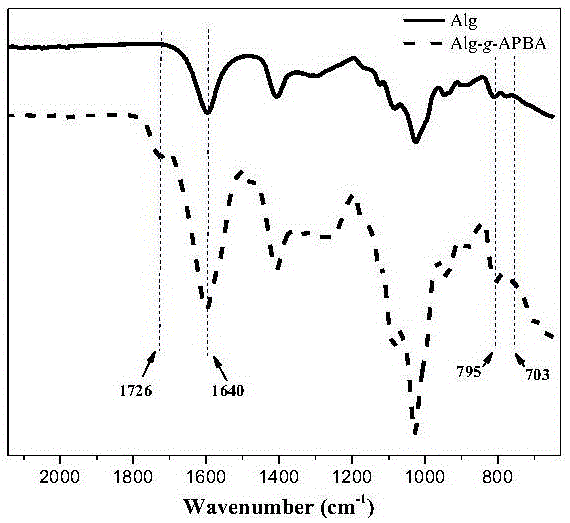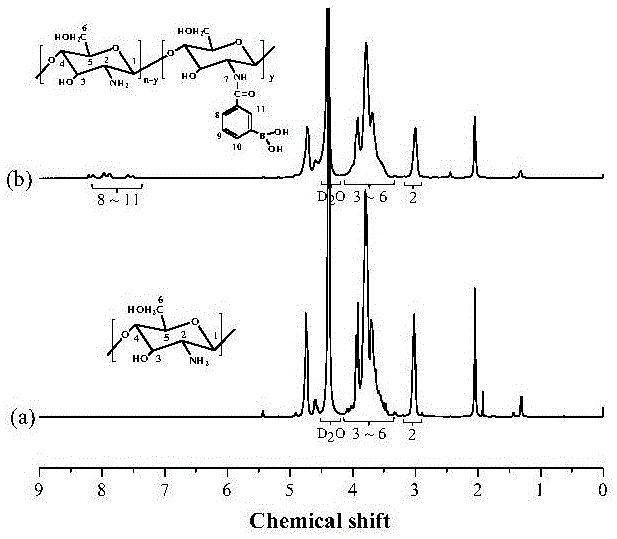Method for preparing multi-layer bio-based vesica capable of releasing insulin
A technology of insulin and bio-based macromolecules, applied in the field of functional materials, can solve the problems of poor biocompatibility and limited application, and achieve the effect of improving stability
- Summary
- Abstract
- Description
- Claims
- Application Information
AI Technical Summary
Problems solved by technology
Method used
Image
Examples
Embodiment 1
[0020] The preparation of embodiment 1, CS-g-CPBA
[0021] Take 1.790g CPBA (5mmol) and dissolve it in 200ml deionized water, add co-catalyst 1.725g N-hydroxysuccinimide (NHS, 15mmol) and 0.960g 1-(3-dimethylaminopropyl)-3-ethylcarbodiimide Amine (EDC, 5mmol), activated under magnetic stirring for 0.5h. Then oligochitosan (5 mmol) in the amount of CPBA and the like was added to the solution, and after reacting for 72 hours at 25° C., the sample was dialyzed for one week and freeze-dried.
Embodiment 2
[0022] The preparation of embodiment 2, Alg-g-APBA
[0023] Dissolve Alg (6 mmol) in 150 ml of water, add co-catalysts 2.070 g NHS (18 mmol) and 1.152 g EDC (6 mmol), and activate for 0.5 h under magnetic stirring. Then APBA (4 mmol) was added to the solution, and after reacting at 25° C. for 72 h, the sample was dialyzed for 7 days and freeze-dried.
Embodiment 3
[0024] Embodiment 3, ((Alg-g-APBA / CS-g-CPBA) 5 ) SiO 2 preparation of
[0025] Prepare Alg-g-APBA, CS-g-CPBA, and insulin into a solution with a concentration of 2mg / ml at pH=5, SiO 2 -NH 2 Prepare a suspension with pH=5 and a concentration of 2 mg / ml, and disperse evenly after ultrasonic treatment for 30 minutes. Take 20ml prepared SiO 2 -NH 2 The suspension was first slowly added dropwise to 20ml of insulin solution, reacted for 30min, then slowly added dropwise with 20ml of Alg-g-APBA solution, reacted for 30min, centrifuged, washed with pH=5 aqueous solution for 3 times, and the nanoparticles were redispersed to pH= 5 solution (20ml) to complete the first layer of assembly. The first layer of assembly suspension was added dropwise to 20ml of CS-g-CPBA solution, centrifuged after 30min of reaction, washed 3 times with an aqueous solution of pH=5, and the nanoparticles were redispersed in an aqueous solution of pH=5 (20ml), Complete the second layer assembly. The ass...
PUM
 Login to View More
Login to View More Abstract
Description
Claims
Application Information
 Login to View More
Login to View More - R&D
- Intellectual Property
- Life Sciences
- Materials
- Tech Scout
- Unparalleled Data Quality
- Higher Quality Content
- 60% Fewer Hallucinations
Browse by: Latest US Patents, China's latest patents, Technical Efficacy Thesaurus, Application Domain, Technology Topic, Popular Technical Reports.
© 2025 PatSnap. All rights reserved.Legal|Privacy policy|Modern Slavery Act Transparency Statement|Sitemap|About US| Contact US: help@patsnap.com



